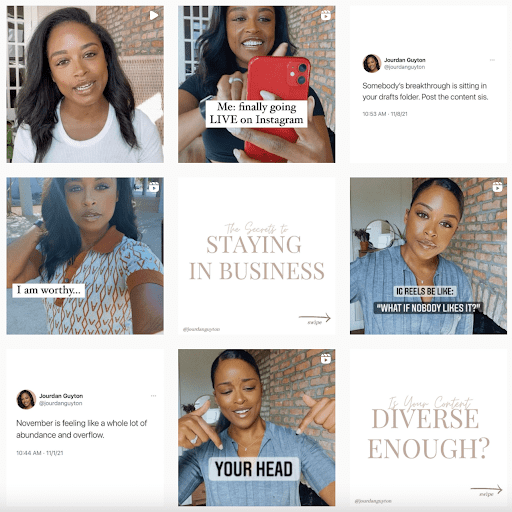Have you been hopping from blog to blog, searching for examples of content buckets to use in your content strategy?
As a content creator, your presence on social media matters, but it can be difficult to know where to start or how to grow your audience organically.
Whether you’re building a brand on your website, Instagram, TikTok, Twitter, Facebook, or all of the above, these examples of content buckets will help you build an effective content strategy. Read on to learn more about why they are essential for online entrepreneurs and how to use them successfully.
What are content buckets?
Content buckets are categories of information that brands and creators use to organize their content. Each bucket is different, but they should all relate back to the overall brand message.
Brands often use six content buckets—education, inspiration, personal, promotion, conversational, and entertainment. However, there are more to consider—which we’ll get into later.
Content buckets are not topics. They are types of content. The buckets you use can vary depending on your business goals.
If you teach soap-making courses, an example of a content bucket would be educational. A topic would be “how to make cold process soap at home.”
We recommend stepping back to assess your goals, so you know which buckets will work best for you. Grounding yourself in your brand’s overarching purpose is crucial to understanding what content your specific audience craves.
Why do content buckets work?
Overall, content buckets are a solid strategy to increase engagement and build your brand.
There is power in crafting different types of engaging content. For instance, visitors will be more engaged by seeing a mix of content rather than three promotional posts in a row.
10 examples of content buckets
Content buckets work because they help you create variety. Using the below examples, you can create different types of content that still align with your target audience and their goals.
This content strategy requires some planning and scheduling posts ahead, but it pays off in the long run.
1. Educational or How-to
For online course creators and coaching experts, this theme is one that will probably come most naturally. Primarily, the educational bucket is used to increase brand credibility by positioning yourself as a knowledge expert in your field. This category can include content such as:
- How-to videos
- Infographics with reliable statistics
- Pro-tips and tricks
- Links to informational blog posts
- FAQs about your business/offerings
2. Personal
The personal bucket is catered toward increasing brand awareness. As an online entrepreneur, you become a part of your brand. People gravitate to you because you’re a person, not a faceless business. It’s easier to relate and connect with an actual person than a profile full of ambiguous graphics and stock photos.
Content can include:
- A “get to know me” series
- Live Q&As
- Action shots of you
3. Promotional
You’ve seen many of these posts on social media, especially for product-focused businesses. Promotional posts make visitors aware of your deals and offerings. However, too many deter people from following you.
Promotional content can be repetitive. If you’re constantly trying to sell something to your audience, it degrades the relationship and trust. Instead of providing value, you could give your audience the impression you only care about making a sale.
Generally, about 20% of your social media content should be promotional. The other 80% needs to be all about providing dynamic posts that offer value.
In other words, there should be a 3:2 ratio of knowledge, value, and community-minded content to sales posts. If you do this, visitors are more likely to stick around for the original, user-focused material.
4. Conversational
Engaging with your community is equally–if not more–important than creating content. With conversational content, you do both. Your audiences want to know they are valuable to your business.
Conversational content creates an open, two-way dialogue. Instead of talking to your followers, you’re listening as well. Some ways to do this include:
- Opening a poll (Instagram Stories is a great place for this)
- Asking a meaningful question
- Doing an Instagram live seminar
5. Entertainment
The entertainment content bucket captures those looking to enjoy themselves. Entertainment posts take a more fun, interactive approach to content.
This type humanizes your brand and makes it more relatable in the eyes of your audience.
Entertainment pieces are also more likely to be re-shared. Whether it’s a funny meme or a comical review of a book or film, make sure it also pertains to your business.
There are several ways to go about generating entertainment content. These include:
- Posting memes on social media
- Leveraging nostalgia by showcasing throwbacks
- Creating entertaining content about passing trends
- Showcasing fun holidays
- Holding contests and giveaways
6. User-generated content
If you don’t have user-generated content, you’re missing one of the most valuable content buckets. One study found that readers consider user-generated content (UGC) 9.8 times more useful than influencer content.
In another study, 90% of consumers said that UGC impacts their purchasing decisions more than any other form of marketing, including email or search engine marketing.
User-generated content is original, brand-specific content created by your customers and published on social media or other channels.
It could be a tweet of someone praising your course or a course review by a happy customer.
Other types of user content include:
- Blog comments
- Forums
- Podcasts
- Reviews
- Facebook comments or posts
If you’re sold on the power of user-generated content, you’ll be glad to learn that leveraging it isn’t as hard as it seems. The best part about UGC—besides that it costs almost nothing—is you’re not putting the work into creating it.
With the following tips, you can source user-generated content:
- Collaborate on content with loyal customers
- Post content from followers on your social media, blog, or YouTube channel
- Use search to find user-generated content on forums such as Quora, Reddit, and Twitter
- Ask your customers to leave a review
7. Product content
Product content refers to the text, imagery, and any other descriptive information that defines your product. Your product content can be anything from your course sales page to your about us page.
Clearly define what your product is and what problem it solves. Otherwise, you risk other people defining your product on your behalf.
Also, product content plays a significant role in lead generation. One statistic shows that 87% of shoppers rate product content as extremely essential when deciding what to buy, and your online courses are no exception.
Here are some tips for product content:
- Speak to your target audience
- Know precisely how and where your target consumers search for product information
- Focus less on the features of your product and more on the benefits your users will get
- Leverage visuals and infographics
- Align and engage your product content with your business strategy
8. Tips and listicles
Did you know listicles are the second most popular type of blog post, behind how-to content? Listicles have been popular for almost a decade now.
A listicle is a type of content that you create in a list format. Blogs about best products, best movies, or best alternatives are all listicles. You also see listicles on TikTok and other social media. These likely started as blogs, which the writer repurposed for a short video.
Readers and writers love listicles because they’re easy to curate and read. If you have a list of 20 tips, you have an outline. Fill in the blanks, and you have a complete listicle.
It’s also easy to write catchy headlines when writing listicle content. Most listicle headlines include numbers—which can increase click rates by 20%.
With that in mind, here are a few tips for writing listicles:
- Look at trends and seasonalities. If you teach sewing, an example could be—12 best sundresses to make this summer.
- Create summary-based meta descriptions
- Include a table of contents so visitors can easily navigate to particular sections
9. Success stories
A customer success story shows how your course or product helped solve a problem and how solving that problem changed your customer’s life.
Most successful customer stories follow a particular structure—the challenge, the solution, and the results.
A well-crafted customer story can achieve a lot for your business. It showcases what your product does, who you created it for, and how real customers used it.
Customer stories differ from case studies because as case studies focus on facts, customer stories focus on experiences.
Fortunately, leveraging stories effectively in your content strategy is easy. You can:
- Build a success story page on your course site and sales page
- Create a case studies section on your website
- Focus on more than just facts and numbers
- Highlight the ROI for every section
- Add testimonials and video clips of your customers telling their stories
10. SEO Content
SEO content refers to content that you create to rank for specific keywords on search engines, mainly Google. Today, almost any content you write should be optimized for search engines.
- 68% of all online activities begin with a search engine
- Search engines generate more than 300% more traffic for websites than social media alone
With a track record like that, it’s easy to see why SEO content is one of the most effective examples of content buckets. SEO content can help you:
- Build brand awareness – When your blogs and other SEO content rank high for keywords, your brand gains more recognition.
- Generate leads – Statistics show that 14.6% of leads from SEO convert into sales.
That said, SEO content must have a specific structure and follow guidelines to rank high in search results. Here are a few tips to help you get started:
- Perform keyword research for all your SEO content
- Strategically place keywords in titles, headers, and meta description
- Build an effective linking strategy (outbound, inbound, and internal links)
- Invest in creating high quality and readable content
{{digitaldownload-component="/blog-shortcodes/blog-popup"}}
Real-life examples of content buckets for creators
Looking for examples of how to use content buckets successfully? Here are a few Teachable creators who used content buckets for social media and are seeing the impact.
Jourdan Guyton
Content coach, producer, and entrepreneur, Jourdan Guyton is no stranger to utilizing content to its fullest potential. As you can see, she diversifies her content and posts consistently. She not only posts educational carousel content but also offers inspirational videos and personal insights. To hear more about Jourdan’s story, check out her episode on the Everything Is Teachable podcast.

Darryl Cheng
Darryl Cheng is the creator of House Plant Journal, one of the most trusted resources in the internet houseplant world. Since making the jump from engineer to full-time digital creator, his Instagram account has amassed half a million followers. Similar to Jourdan, Darryl varies his content based on his business’s goals. From a meme about skylights to an infographic on solar paths, House Plant Journal is a thriving platform.

Tori Dunlap
Tori Dunlap is a personal finance expert whose mission is to help empower women through financial literacy and wellness. With this, her branding is just as solidified as her clearly established mission statement.
Another successful example of a content bucket strategy, Tori implements different categories to help build her brand and cater to her audience. There is everything from educational statistics to a conversational post about a free quiz in her bio. It’s easy to see why her audience grew from 30,000 to two million in just one year.

Building a content strategy from scratch can seem daunting at first. However, with these examples of content buckets, you can brainstorm and group topics faster. Your content will be organized and relevant to your audience.
Join more than 150,000 creators who use Teachable to make a real impact and earn a real income.


.png)
.png)



